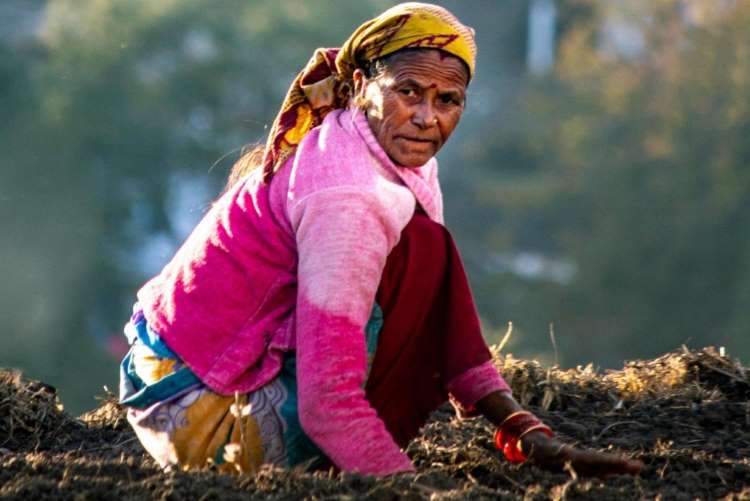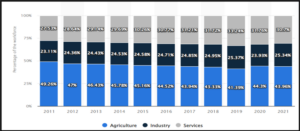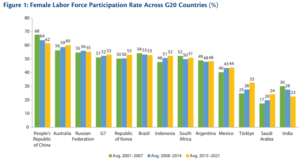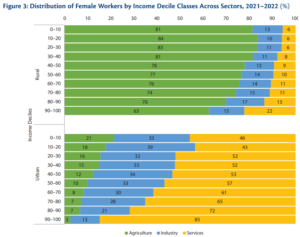
Feminisation of agriculture in India: Agriculture contributes just 15% of India’s GDP, but employs more than half of the country’s population. India is among the largest producers of rice, wheat, milk, jute, pulses, sugarcane, cotton, groundnuts, fruit, and vegetables. Agricultural products rank among India’s top five exports.
While agriculture remains a pillar of India’s economy, it also poses significant risks. The sector is a major consumer of water and emitter of greenhouse gases, particularly of methane from rice paddies and livestock. Unsustainable farming practices have led to soil degradation, deforestation, and biodiversity loss. Addressing these environmental impacts is crucial for the sustainability of agriculture and the health of the planet. Initiatives aimed at promoting sustainable agriculture practices are essential to mitigate these effects while ensuring the sector’s viability for future generations.
Distribution of the workforce across sectors

There is potential for enhancing the contribution of agriculture through modern marketing strategies, and farmer producer organisations. This is key to improving farmers’ living conditions by providing end-to-end support in cultivation, technical services, processing, and marketing. According to the Periodic Labour Force Survey (PLFS) conducted by the National Sample Survey Office (NSSO), during 2022-23, about 45.76% of the total workforce is engaged in agriculture and allied sectors.
READ I Spectrum allocation: Government seeks greater flexibility
Feminisation of agriculture in India
It is estimated that the actual farmer population of India is approximately 36.1 million and is decreasing. There are several reasons for this decline, with unstable income and vulnerability being the primary ones. As a result, many farmers are relocating to cities, leaving their lands to be managed by the women in their families. This shift has given rise to the feminisation of agriculture, the emergence of female farmers and agripreneurs, spurred by digitisation.
The era of the feminisation of agriculture reflects the current situation where this new class is breaking stereotypes and matching the traditional image of male farmers. According to Niti Aayog, a large number of women are involved in agricultural activities, reinforcing their indispensable role in India’s agricultural narrative. However, women own only about 12% of the agricultural land in India (Challenges and Opportunities for Women Farmers in India, 2023).


Female farmers face persistent challenges including limited land ownership rights, gender-based violence, assault, harassment, restricted access to credit and resources, and exclusion from decision-making processes. These issues, rooted in patriarchal norms, hinder their full participation and success in agriculture. However, initiatives are changing the landscape; legal changes like the 2005 amendment granting equal property rights to daughters, and the Forest Rights Act of 2006, which includes joint titling provisions, promote gender equality in land rights.
A 1985 policy encouraged joint titles in asset transfers to spouses. The Land Acquisition Act of 2013 defines affected families to include landowners and dependents, allowing landless women engaged in farming and livestock rearing to be entitled to rehabilitation support (Challenges and Opportunities for Women Farmers in India, 2023).
Special credit facilities such as the Mahila Kisan Sashaktikaran Pariyojana (MKSP) are provided to female farmers. Initiatives like e-NAM aim to improve market access for female farmers. Programmes like the National Nutrition Mission and PMMVY focus on improving the health and nutrition of female farmers.
Digital platforms like KisanKonnect facilitate the direct selling of produce to consumers, eliminating intermediaries and ensuring better prices. By leveraging such platforms, women farmers can increase their income by as much as 30% compared with traditional markets. The platform supports the adoption of regenerative agriculture practices, leading to better yields and productivity, and aligns with the United Nations’ theme of ‘DigitAll – Innovation and Technology for Gender Equality,’ reducing the gender gap and promoting sustainability (Ranjan, 2023).
Maharashtra is leading the way in feminisation of agriculture. MAVIM (Mahila Arthik Vikas Mahamandal) is working with over 1.8 million women, including 1 million smallholder women farmers organized through self-help groups (SHGs) and district-level federations. MAVIM partners with private sector organisations to provide women farmers access to finance, inputs, and markets through digital platforms. They integrate SHGs with supply chain firms, financial services, and input suppliers, leveraging mobile technologies and remote sensing services to enhance access to markets and information.
MAVIM delivers agritech services through a phygital model, combining on-ground resources with digital technologies to educate, onboard, and support farmers. This approach not only enhances women farmers’ access to advisory services and inputs but also digitises federations’ business operations, generating data for customised agritech services. Through these initiatives, MAVIM is empowering women farmers in Maharashtra with digital tools for prosperity and well-being (Leveraging Tech for India’s Women Farmers in Maharashtra #Wef24, 2023).
The interim budget of 2023-24 brings hope for the inclusion of enhanced women farmers’ participation in the agrarian economy. The rise of women in Indian agriculture marks a transformative shift towards inclusivity and empowerment. Despite challenges, legal reforms and digital innovations have catalysed progress, enabling women farmers to access markets and resources. Yet, the journey towards gender equality continues. Sustained efforts are vital to ensure that these gains translate into lasting change, fostering a more prosperous and equitable agricultural sector for all.
(Richa Bhardwaj is a student at BIMTECH, Greater Noida.)
